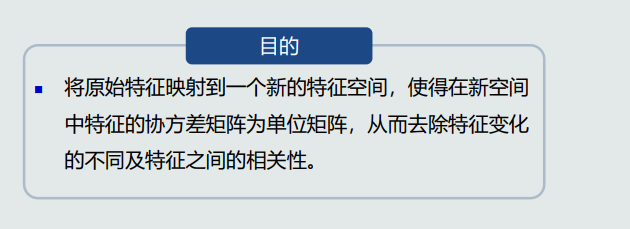机器学习第二章笔记
/ / 点击 / 阅读耗时 5 分钟第二章
1.MED分类器
均值是对类中所有训练样本代表误差最小的一种表达方式
MED分类器采用欧式距离作为距离度量,没有考虑特征变化的不同及特征之间的相关性
1.对角线元素不相等:每维特征的变化不同
2.非对角元素不为0:特征之间存在相关性
代码
1
2
3
4
5
6
7
8
9
10
11
12
13
14
15
16
17
18
19
20
21
22
23
24
25
26
27
28
29
30
31
32
33
34
35
36
37
38
39
40
41
42
43
44
45
46
47
48
49
50
51
52
53
54
55
56
57def MED(dataset, is_2d=None):
# 实现MED分类器
train = dataset['train']
test = dataset['test']
target = dataset['target']
train_pos_mean_2d = None
train_neg_mean_2d = None
# 画2d图
if is_2d == True:
scaler = pre.StandardScaler()
pca = PCA(n_components=2)
train_2d = copy.deepcopy(train)
label = train_2d[:, -1]
train_2d = scaler.fit_transform(train_2d[:, :4])
train_2d = pca.fit_transform(train_2d)
train_2d = np.c_[train_2d, label]
train_pos = np.array(train_2d[train[:, -1] == target[0]])
train_neg = np.array(train_2d[train[:, -1] == target[1]])
train_pos_mean_2d = np.mean(train_pos[:, :2], axis=0)
train_neg_mean_2d = np.mean(train_neg[:, :2], axis=0)
# target[0]为正样本,target[1]为负样本
train_pos = np.array(train[train[:, -1] == target[0]])
train_neg = np.array(train[train[:, -1] == target[1]])
print('positive num:', train_pos.shape)
print('negative num:', train_neg.shape)
# 分别取平均
train_pos_mean = np.mean(train_pos[:, :4], axis=0)
train_neg_mean = np.mean(train_neg[:, :4], axis=0)
x_test = test[:, :4]
y_test = test[:, -1].flatten()
y_pre = np.array([])
for i in range(x_test.shape[0]):
# 欧氏距离
dis_pos = (x_test[i] - train_pos_mean).T @ (x_test[i] - train_pos_mean)
dis_neg = (x_test[i] - train_neg_mean).T @ (x_test[i] - train_neg_mean)
# 预测
if dis_pos < dis_neg:
y_pre = np.append(y_pre, target[0])
else:
y_pre = np.append(y_pre, target[1])
# 准确率
acc = (y_pre == y_test.astype(int)).sum() / y_test.shape[0]
print(acc)
if is_2d == True:
return train_pos_mean_2d, train_neg_mean_2d
else:
return y_test, y_pre
2.特征白化
目的

步骤
1.解耦,去除特征之间相关性,即使对角元素为0,矩阵对角化
2.白化,对特征进行尺度变化,使所有特征具有相同的方差
原始特征投影到协方差矩阵对应的特征向量上,其中每一个特征向量构成一个坐标轴
转换前后欧氏距离保持一致,W1只起到旋转作用
代码
1
2
3
4
5
6
7
8
9
10
11
12
13
14
15
16
17
18
19
20
21
22
23
24
25
26
27
28
29
30
31
32
33
34def whitening(dataset):
# 进行特征白化
data = dataset.data
print('data shape:', data.shape)
# 计算协方差矩阵
cov = np.cov(data, rowvar=False)
print('cov shape:', cov.shape)
# 特征值,特征向量
w, v = np.linalg.eig(cov)
print('w shape:', w.shape)
print('v shape:', v.shape)
# 单位化特征向量
sum_list = []
for i in range(v.shape[0]):
sum = 0.
for j in range(v.shape[1]):
sum += v[i][j] * v[i][j]
sum_list.append(math.sqrt(sum))
for i in range(v.shape[0]):
for j in range(v.shape[1]):
v[i][j] /= sum_list[i]
# 计算W
W1 = v.T
print('W1 shape:', W1.shape)
W2 = np.diag(w ** (-0.5))
print('W2 shape:', W2.shape)
W = W2 @ W1
print('W shape:', W.shape)
data = data @ W
print('data shape', data.shape)
return data
3.MICD分类器

代码有空再补